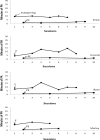The effects of exergaming on physical activity among inactive children in a physical education classroom
- PMID: 21541146
- PMCID: PMC2998252
- DOI: 10.1901/jaba.2010.43-591
The effects of exergaming on physical activity among inactive children in a physical education classroom
Abstract
Childhood obesity, which is due in part to lack of physical activity, is a serious concern that requires the attention of the behavioral community. Although excessive video game play has been noted in the literature as a contributor to childhood obesity, newer video gaming technology, called exergaming, has been designed to capitalize on the reinforcing effects of video games to increase physical activity in children. This study evaluated the effects of exergaming on physical activity among 4 inactive children in a physical education (PE) classroom. Results showed that exergaming produced substantially more minutes of physical activity and more minutes of opportunity to engage in physical activity than did the standard PE program. In addition, exergaming was socially acceptable to both the students and the PE teacher. Exergaming appears to hold promise as a method for increasing physical activity among inactive children and might be a possible intervention for childhood obesity.
Keywords: childhood obesity; exergaming; physical education; social validity; video games.
Figures


References
-
- American Academy of Pediatrics. Committee on Nutrition. Policy statement: Prevention of pediatric overweight and obesity. Pediatrics. 2003;112:424–430. - PubMed
-
- Anderson R.E, Crespo C.J, Barlett S.J, Cheskin L.J, Pratt M. Relationship of physical activity and television watching with body weight and level of fatness among children. Journal of the American Medical Association. 1998;279:938–942. - PubMed
-
- Brownson R.C, Boehmer T.K, Luke D.A. Declining rates of physical activity in the United States: What are the contributors. Annual Review of Public Health. 2005;26:421–443. - PubMed
-
- Centers for Disease Control and Prevention. Overweight and obesity. 2007. Retrieved from http://www.cdc.gov/nccdphp/dnpa/obesity/
-
- Crawford D.A, Jeffery R.W, French S.A. Television viewing, physical inactivity, and obesity. International Journal of Obesity. 1999;23:437–440. - PubMed
MeSH terms
LinkOut - more resources
Full Text Sources
Medical

